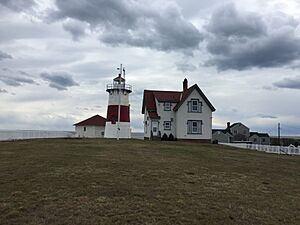Lordship, Connecticut facts for kids
Quick facts for kids
Lordship, Connecticut
|
|
|---|---|

Stratford Point Lighthouse in 2016
|
|

Map of Greater Bridgeport showing Lordship
|
|
| Country | |
| State | |
| County | Fairfield |
| Town | Stratford |
| Time zone | UTC-5:00 (Eastern) |
| • Summer (DST) | UTC-4:00 (Eastern) |
| Area code(s) | 203 |
Lordship is a small, pretty neighborhood right on the water in Stratford, Connecticut. It's part of what's called Connecticut's Gold Coast. Before the 2020 census, it was listed as a census-designated place. This means it's a special area that the government tracks for population information, even though it's not an official town.
Lordship used to be an island surrounded by salty marshes to the north and the Long Island Sound to the south. Over time, people added land, turning it into a peninsula. Now, it sticks out into Long Island Sound. The Sikorsky Memorial Airport is to its north, and Short Beach is to its northeast. You can only get to Lordship by two roads, both part of Route 113.
Lordship is also home to the historic Stratford Point Light, a lighthouse that helps guide ships.
Contents
A Look Back: Lordship's History
Early Days: The Paugussett People
The very first people to live in Lordship were the Paugussett Indians. They had a big village near a place called Frash Pond. They also had smaller camps at Stratford Point and Indian Well, which are both areas within Lordship today.
Indian Well was a natural pond with fresh water. It was located where an old trolley line used to cross Duck Neck Creek. When the first European settlers arrived in 1639, they found that the Paugussetts were already growing corn in this area. This meant the settlers didn't have to clear much land themselves.
How Lordship Got Its Name
Lordship was first called "Great Neck." It was a "Common Field," which means it was land worked and shared by the early settlers. These settlers would return to the safety of a fort at Academy Hill every night.
Richard Mills was one of the first settlers to build a farmhouse in Great Neck. His farm was in the western part, near where Second Avenue is now. In 1650, he sold his farm to Joseph Hawley (Captain) and moved away. It was around this time that the name Lordship first appeared. It was used to describe a meadow on what is still known as the Lordship farm. Old documents from the 1650s and 1660s often mention "Mill’s Lordship" and the "Lordship Meadow."
In 1662, Richard Beach bought five acres of land "on west point of the Neck." This land was next to the meadow called "Mill’s Lordship." This shows how the name "Lordship" became connected to this area.
Early Flight Experiments
Lordship's open, sandy areas were also important for early aviation. Gustave Whitehead, a pioneer in flight, is said to have used these windy spots for some of his first powered flight tests. This happened in the early 1900s, long before many people believed that flying was possible!

